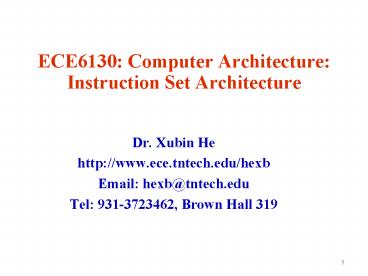ECE6130: Computer Architecture: Instruction Set Architecture - PowerPoint PPT Presentation
1 / 22
Title:
ECE6130: Computer Architecture: Instruction Set Architecture
Description:
Register. Location in memory (effective address) See figure 2.6 ... addressing: a displacement mode using PC as register and used primarily for ... – PowerPoint PPT presentation
Number of Views:62
Avg rating:3.0/5.0
Title: ECE6130: Computer Architecture: Instruction Set Architecture
1
ECE6130 Computer ArchitectureInstruction Set
Architecture
- Dr. Xubin He
- http//www.ece.tntech.edu/hexb
- Email hexb_at_tntech.edu
- Tel 931-3723462, Brown Hall 319
2
- Previous Class
- Introduction ot ISA
- ISA classification
- Today
- Memory addressing
3
Memory Addressing
- Addressing Memory how to specify and interpret
memory address is important since all data are
initially in the memory. - Interpreting Memory Addresses
- All computers, except DSPs, are byte-addressed,
providing access for bytes, half-words (2 bytes),
words (4 bytes), and double words (8 bytes)
4
(No Transcript)
5
Memory Addressing
- Ordering bytes within a larger object 8 bytes in
a double word - Little Endian
- Big Endian
6
(No Transcript)
7
(No Transcript)
8
Memory Addressing
- Alignment of bytes
- an access to an object of size s bytes at byte
address A is aligned if A mod s 0. - Memory is aligned on a multiple of a word or
double-word boundary - In general
- object larger than 1 byte must be aligned to
reduce HW complexity
9
Text Book, Figure 2.5
10
Addressing Mode
- How architectures specify an address of an object
to be accessed - Addressing mode can specify
- Constant
- Register
- Location in memory (effective address)
- See figure 2.6
- PC-relative addressing a displacement mode using
PC as register and used primarily for specifying
code addresses in branches - Complex addressing mode
- Reduce instruction counts a lot
- Add complexity (may increase the cycle time)
- Increase average CPI
- Know what modes to include is important
11
Figure 2.6 addressing modes (page 98)
12
What Addressing Modes are Common?
- Measure VAX using three SPEC89, which supports
all Addressing modes in figure 2.6 - Immediate and displacement dominate (not
including PC-relative and register) - See figure 2.7
13
Figure 2.7 summary of memory addressing mode
14
Immediate or Literal AM
- Use of immediate
- Arithmetic operations
- Comparisons (primarily for branches)
- Moves where a constant is wanted in a register
- Constants written in code (small)
- Add reg , 2
- Address constants (large)
- Need to know whether they need to be supported by
all Ops or for only a subset
15
Frequency of Immediate for Different Instructions
- Very high in ALU and comparisons gt many are 0
- See figure 2.9
- Data taken on Alpha architecture with full
optimization for SPEC CPU 2000, integet CINT2000
and FP CFP2000
16
Figure 2.9 CINT2000 in SPEC CPU 2000
17
Range of Immediate Values
- Range affects instruction length
- Small values are most common
- Large values sometimes address calculations
- See figure 2.10
- Data taken on Alpha architecture with full
optimization for SPEC CPU 2000, integet CINT2000
and FP CFP2000
18
Figure 2.10 distributions of immediate values
19
Displacement Addressing Mode
- What ranges Displacement used?
- Various displacement sizes determine the length
of the displacement field -gt length of
instructions - Displacement for data accesses (not branches)
- See figure 2.8
20
Figure 2.8 displacement values
21
Memory Addressing Summary
- Use a GPR machine a reg-reg one
- A new ISA at least support the following
addressing modes - Displacement
- Immediate 75-99 of AM
- Reg indirect
- Size of the address for displacement modes to be
at least 12-16 bits gt 75-99 of displacements - Immediate field is at least 8-16 bits gt
capture 50-80 of immediates
22
Next
- Type and size of operands
- Operations
- Read Chapter 2.5-2.8































